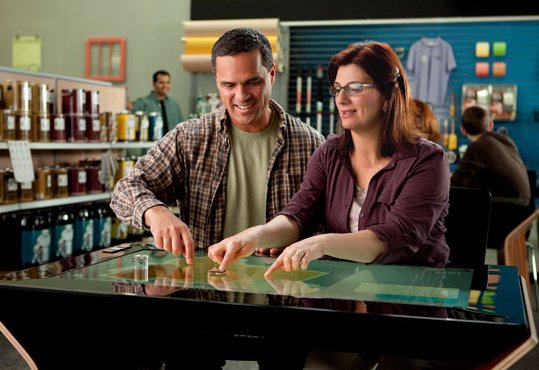Microsoft Surface tablets: Did a table just shrink down to a tablet?

Microsoft officials have been hinting for a couple of years that they hoped to someday shrink down the table-sized multitouch Surface technology and make it available in a tablet form factor.

The short answer: No.
Here's a bit of background on the Surface.
Microsoft introduced the Surface 1.0 technology, formerly codenamed "PlayTable" and then "Milan," in 2007. Second-generation, cheaper ($8,400) and thinner versions of the Surface began shipping in January of this year.
Just before this week's June 18 announcement of Microsoft's two new Windows 8 tablets, there were rumors going around about Microsoft making a tablet branded the "Xbox Surface." The leaked documents about this supposed tablet may have been -- and probably were -- fake. But I wasn't surprised that such a product/technology could actually be in the pipeline, given Microsoft's previous statements about wanting to put the Surface on a diet.
Turning a table full of cameras and a projector into a tablet without the same internal infrastructure would be no mean feat. Microsoft Principal Researcher Bill Buxton explained the challenges to The Globe and Mail in 2010:
"Right now (the Surface 1) has five cameras in it and a projector and a bunch of other stuff. It's just a lot. What will happen is that Surface will become no thicker than a sheet of glass. That will more or less be true. It's not going to have any cameras or projectors because the cameras will be embedded in the device itself.
"The best way to think about it is like a big LCD where there's a fourth pixel in every triad. So there's red, green, and blue pixels giving you light, and a fourth pixel which is a sensor that will capture stuff; go the other direction."
Buxton was describing PixelSense, a Microsoft-developed (and trademarked) technology that uses the pixesls of a screen as cameras, capturing objects placed on the screen's surface. PixelSense is now the branding Microsoft is using for the table-sized multitouch Surface devices; all references to "Surface" with those devices is being expunged from Microsoft's Web sites and marketing materials.
The Samsung SUR40 (second-generation Surface table) device supports 50 simultaneous touch points, as well as all kinds of gestures like swiping, painting, etc. Windows 8 requires five-touch-point support (last I read), but also supports a wide variety of gestures. A table and a tablet are two very different form factors, obviously.
However, I have heard that some of the guts of the ClearType display technology -- the optical-bonding, sub-pixel rendering and pixel blending described during yesterday's Surface tablet unveiling -- were products of early research by some members of the original Surface team. Some of the people who worked on the original Surface team seem to have moved on at some point to work on the Microsoft Surface design and engineering team.
Steven Bathiche, the Director of Research for the Applied Sciences Group in Microsoft Hardware is one of those who worked on the table-sized Surface at one point.As ZDNet UK's Mary Branscombe reported, the new technology inside the Surface Touch Cover first showed up in the Sidewinder x4 gaming keyboard in 2010. Bachiche invented the SideWinder Freestyle Pro game pad, "the first commercial gaming device to use accelerometers."
So has the "big-ass table" (as a spoof video called the original Microsoft Surface tabletop introduced in 2007) now a 10-inch tablet? No. The new Surface tablets are Surfaces mostly in name only.